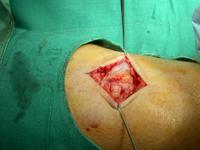| Good Stuff |
| Spot Diagnosis |
| Skin |
|
|
|
|
|
|
|
|
|
|
|
|

|
Click on the image to download a larger version |
|
With respect to the sural nerve.
|
|
The Skin |
| Last updated (19 November 2003) |
|
|
The sural nerve is a purely sensory nerve. It travels with the small saphenous vein. It supplies the skin behind the lateral malleolus and on the lateral side of the foot.
The sural nerve supplies sensation to the lateral part of the foot. It contains no motor fibres. It travels with the short saphenous vein.
The sural nerve may be biopsied in patients with peripheral neuropathy for histological examination and investigation of their complaint. In most of these patients the nerve is not functioning and biopsy does not result in any loss of function. If the nerve is still functioning the main complaint is an area of numbness on the lateral part of the foot. The patient should be warned about this prior to performing the biopsy. It is important to ensure that the correct side is biopsied, if the patients symptoms are worst on one side then this may be the best side to biopsy, the side chosen should be discussed with the physician responsible for the patient, documented in the patients chart, on the consent form and the side marked and initialled (anteriorly, posteriorly and laterally) on the patient.
The sural nerve is prone to injury (as are many cutaneous nerves) during any surgery in its vicinity.
Operations to remove varicose veins are complicated by cutaneous nerve damage in about 5% of patients. Most of these injuries are temporary and are manifest by numbness. Some are permanent and the patient may complain bitterly of paresthesia and a painful neuralgia.
Stripping of the long saphenous vein below the knee is not advised because of the intimate relationship between the vein and the saphenous nerve which often spirals around the vein and is attached to it by fascia. Stripping the vein may also strip the nerve.
It is vital to warn the patient prior to the operation of the possibility of cutaneous nerve damage and to document this in the patient's notes and on the consent form.